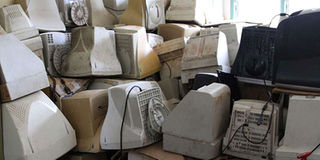Danger in the growing digital garbage

Heaps of unusable computers. Recycling is the best way to dispose of e-waste. PHOTO | FILE | NATION MEDIA GROUP
What you need to know:
- The human scavengers are exposed to intractable health challenges: burns, septic wounds, eye damage and a plethora of respiratory problems.
- Parliament must create policies on how to recycle e-waste, and enforce and incentivise people to use them.
In just two decades, mobile phones and laptops have grown from oddity to ubiquity, and so are many other home electronics.
Similarly, heaps of cracked computers, unusable mobile phones, electric cables, dead television sets and defective fridges contribute to a growing menace of electronic waste.
E-waste – as it is commonly known – is the most rapidly growing waste problem in the world. Collectively, the world generates about 40 million tonnes of e-waste every year — equivalent to throwing out nearly 60,000 laptops every time you blink.
Of these, Kenya contributes about 45,000 tonnes a year, equivalent to about 10 kilogrammes for each Kenyan.
With the lifespan of gadgets shortening and our population surging, the digital junkyards are swelling with waste at a worrying pace.
Here is the sobering point: E-waste contains harmful materials. It’s a cesspool of toxic components, including mercury, lead, cadmium, barium and lithium.
HEALTH
Oblivious of these harmful elements, many families spend their days on the dumpsites rummaging for scrap metals without a modicum of protective gear.
They smash the devices to get coveted metals, especially copper, which they sell to traders for recycling.
What is at stake? The human scavengers are exposed to intractable health challenges: burns, septic wounds, eye damage and a plethora of respiratory problems.
Studies show that other common complains include chronic nausea, splitting headaches and respiratory problems. Many of the victims, sadly, succumb to cancer.
Ignorant of inherent dangers, many individuals and companies dispose by burning their obsolete electric devices. Harmful emissions from lead in circuit boards or cathode ray tube glass, leach into soil, water and food.
Food and drinks end up on the dinner table and finally in our bodies, causing stubborn sicknesses.
RECYCLING
With lax laws and half-hearted enforcement of the existing anti-dumping laws, Africa is the graveyard to dead or dying electronics from rich Western countries.
In some countries, the so-called free-trade agreements are tacit agreements for dumping devices from the rich countries to the poor ones.
This is why we can’t remain complacent as this menace grows. If left unchecked, e-waste is growing to become a serious health headache.
Some of the strange diseases that we are starting to see could be the bellwether of worse things on the horizon.
Recycling is the best way to dispose of e-waste but Kenya and other developing countries are remiss on the problem. Parliament must create policies on how to recycle e-waste, and enforce and incentivise people to use them.
WASTE MANAGEMENT
Importantly, we need to create awareness among people on good disposal procedures. The country should also declare a moratorium on imports of derelict devices.
Proper e-waste disposal is an absolute imperative. Everyone should pitch in. It’s an all-hands-on-deck exercise but the government must show and lead the way, the same way it did for the polythene bags.
Mr Wambugu is an informatics specialist. Email: [email protected] @samwmambugu2





